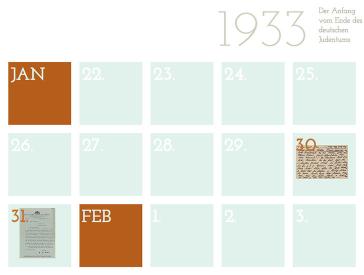The Story of Uri Kozower
Lawyer Philipp Kozower was 37 when he married the 23-year-old medical student Gisela in 1931. A year later she gave birth to their first child, a daughter called Eva. The new parents had their picture taken with their baby in Berlin’s Monbijou Park: wearing a bright dress and straw hat, Gisela holds the baby towards the camera somewhat awkwardly, as if the picture should document that Eva exists.
By the time Eva’s sister Alice was born in 1934, the National Socialists had already enacted numerous laws against Jews as well as taken measures to exclude them from public life. Our online project 1933: The beginning of the end of German Jewry presents a variety of source materials from the Jewish Museum Berlin’s archives that bear witness to the disenfranchisement of German Jews. A display case with photographs and letters in our permanent exhibition details the Kozower family’s story:
The family’s youngest child was born in 1942. At this point Jewish parents in Germany were not permitted to name their children freely; rather, they had to choose from a list of acceptable names published by the Interior Ministry. Otherwise, newborn children – as all German Jews starting in 1939 – would simply be given the name Sara or Israel, depending on the gender. Gisela and Philipp chose the name Uri from the list. When Uri was three months old, the family was deported to Theresienstadt. From there they regularly wrote letters to relatives. Every letter is about the little boy: soon he’ll be able to hold his bottle by himself, he’s starting to crawl, he’s turning one.
“Uri is just adorable. He repeats everything we say now, and timidly tries to walk by himself,”
 X
X
Gisela and Philipp Kozower with their daughter Eva, Berlin 13 August 1932; Jewish Museum Berlin, accession 2003/141/332, gift of Klaus M. Zwilsky
writes the ten-year-old Alice in July 1944. In October of 1944, Philipp, Gisela, Eva, Alice, and Uri are transported to Auschwitz. They are among the last people to be murdered in that death camp’s gas chambers.
A relative of the family, Klaus Zwilsky, saved the pictures together with the letters from Theresienstadt and donated them to the museum. Thanks to his conscientiousness and generosity, we’re able to tell the Kozower family’s story to our visitors. By displaying pieces like this in our permanent exhibition, we do the one thing we can in the face of Auschwitz: we make sure that the names, faces, and stories of the people killed there are not forgotten – not on January 27 or on any other day of the year.
Monika Flores Martínez, Permanent Exhibition
 X
X
Eva and Alice Kozower with a picture book, Berlin ca. 1938; Jewish Museum Berlin, accession 2003/141/333, gift of Klaus M. Zwilsky
Citation recommendation:
Monika Flores (2014), The Story of Uri Kozower.
URL: www.jmberlin.de/en/node/6725




